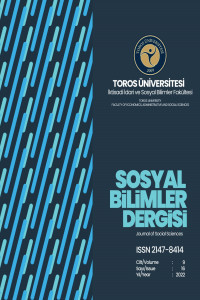ÜÇ BOYUTLU AĞIRLIK MERKEZİNİN TESPİTİNE DAYANARAK AĞIRLIK MERKEZİ KONUMUNUN DEVRİLME ÜZERİNDEKİ ETKİLERİ
D3DCG, Doğal frekans, devrilme kazası, trafik güvenliği
EFFECTS OF CENTER OF GRAVITY POSITION ON ROLLOVER BASED UPON DETECTION OF THREE-DIMENSIONAL CENTER OF GRAVITY
D3DCG, Natural frequency, Rollover accident, Traffic safety,
___
- [1] Chen, B., and Peng, H. (1999). Rollover warning of articulated vehicles based on a Time-To-Rollover metric. Proceedings of the 1999 ASME International Congress and Exposition, Knoxville, TN, November 1999.
- [2] Dang, R., and Watanabe, Y. (2016). Three-Dimensional Center of Gravity for Trucks Hauling Marine Containers. Journal of Engineering Research and Applications, 6(1), 27-34.
- [3] Fan, L., Li, G. Y., Chen, R., Hu, D. W., Zhao, L., and Hu, L. H. (2016). Speed calculation model and simulation of rollover prevention in condition of extreme turn based on lateral force coefficient. Transactions of the Chinese Society of Agricultural Engineering, 32(3), 41-47.
- [4] He, J. L., Gong, B., Zhu, T., Yang, C. X., and Sun, Y. F. (2017). Critical safety speed model of corners based on road geometry parameters. Journal of Changsha University of Science and Technology (Natural Science), 14(4), 75-82.
- [5] Huang, Y., Jiang, G. L., Sun, Z., Duan, W. J., and Tuo, Y. H. (2009). Research on Vehicle Speed Precaution System Set on Highway Curve Based on Image Processing Technology. Journal of Shandong Jiaotong University, 17(4), 23-27.
- [6] Iranitalab, A., Khattak, A., and Bahouth, G. (2020). Statistical modeling of cargo tank truck crashes: Rollover and release of hazardous materials. Journal of Safety Research, 74, 71-79.
- [7] Kawashima, S., and Watanabe, Y. (2016). Center of gravity detection for railway cars. Open Journal of Mechanical Engineering (OJME), 1(1), 8-11.
- [8] Lang, M. X., Peng, Y. Z., and Liu, C. Q. (2010). Influence of gravity center height on running safety of loaded double-stack container car. Journal of Traffic and Transportation Engineering, 10(6), 41-47.
- [9] McKnight, A. J., and Bahouth, G. T. (2008). Analysis of Large Truck Rollover Crashes. Annals of Advances in Automotive Medicine, 52, 281-288.
- [10] Mikata, Y., Yamanaka, M., Kameoka, K., Okunosono, A., and Kinoshita, T. (2011). Measuring the center of gravity with truck scale, Proceedings of SICE Annual Conference 2011, 405-410.
- [11] Ministry of Land, Infrastructure, Transport and Tourism. (2020). Annual report on automobile accident statistics for automobile transportation business (Information on the safety of automobile transportation) (First year of Reiwa), Japanese Government, 1-75.
- [12] Rogers, S., and Zhang, W. (2003). Development and evaluation of a curve rollover warning system for trucks. Institute of Electrical and Electronics Engineers (IEEE), 294-297.
- [13] Ryu, Y. I., Kang, D. O., Heo, S. J., and In, J. H. (2010). Rollover Mitigation for a Heavy Commercial Vehicle. International Journal of Automotive Technology, 11(2), 283-287.
- [14] Suetake, Y., Oya, M., Shu, P., and Zhuo, J. (2014). Adaptive rollover prevention controller for driver–vehicle systems. Artif Life Robotics, 19, 9-15.
- [15] Sun, C., Wu, C. Z., Chu, D. F., Fu, Y. H., and Cui, H. L. (2015). Improved Model Study of Safety Speed Calculation in Curves. China Journal of Highway and Transport, 28(8), 101-108.
- [16] Watanabe, Y. (2017). Three-Dimensional Center of Gravity Detections for Preventing Rollover Accidents of Trailer Trucks Hauling Containers. Open Journal of Mechanical Engineering (OJME), 2(1), 11-14.
- [17] Wu, X. H., Ge, X. H., Luo, S. Y., and Huang, H. W. (2014). Study on Stability of Rollover of Vehicle. Journal of Xiamen University (Natural Science), 49(6), 815-818.
- [18] Yang, Y., and Qiu, X. (2019). The conditions and influencing factors of trucks’ roll-over during turning. Mechanics in Engineering, 41 (4), 393-397.
- [19] Yu, G. Z., Li, Q., Wang, Y. P, and Wang, D. (2014). Roll Stability and Early-warning of Vehicle Driving in the Curve. Journal of Beijing University of Technology, 40(4), 574-579.
- [20] Zhu, T., and Zong, C. (2009). Research on Heavy Truck Rollover Prevention Based on LMI Robust Controller. 2009 IITA International Conference on Control, Automation and Systems Engineering, 167-170.
- ISSN: 2147-8414
- Yayın Aralığı: Yılda 2 Sayı
- Yayıncı: Toros Üniversitesi
SIVILAŞTIRILMIŞ DOĞAL GAZ TAŞIMA YOLLARININ AĞ TABANLI OPTİMİZASYONU
RESEARCH ON SUSTAINABLE CRITERIA AFFECTING THE LOGISTICS SECTOR
JAPONYA'DA SÜRDÜRÜLEBİLİR LOJİSTİK İÇİN MAKİNE ÖĞRENİMİ İLE YÜKSEK KAPASİTELİ ARAÇLARIN VERİ ANALİZİ
Thuta Kyaw WIN, Daisuke WATANABE, Tetsuro HYODO
FREIGHT TRANSPORTATION AND THE COVID-19 OUTBREAK: FRESH INSIGHTS FROM THE US ECONOMY
Esranur YILMAZ, Mehmet Aldonat BEYZATLAR
